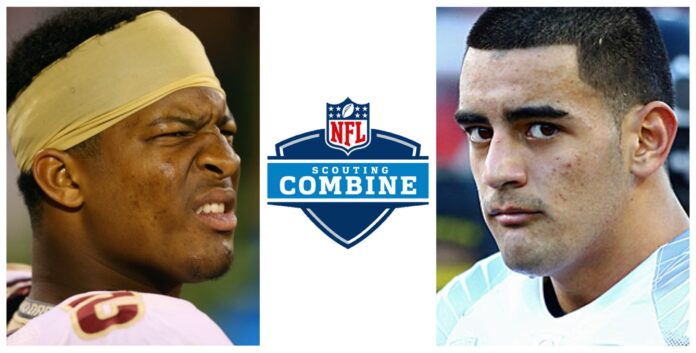Winston & Mariota Must Make the Best Decision (Not Throw)
As the NFL Scouting Combine kicks off today, we find ourselves in that annual season where the NFL draft’s most promising prospects undergo a thorough evaluation.
Once again, the spotlight shines brightly on the cream of the quarterback crop – Jameis Winston and Marcus Mariota, leading the way this year.
These exceptional talents, boasting Heisman Trophies and impressive track records, have undoubtedly set themselves apart from their fellow quarterbacks in the 2015 NFL Draft class.
They are considered surefire first-round picks, even before setting foot in Indianapolis. This leads us to ponder a pertinent question:
Is it necessary for either of these quarterbacks to showcase their throwing skills at the Combine?
The NFL Combine was initially conceived to gather vital medical background data on aspiring NFL players.
Over time, it has transformed into a multifaceted event encompassing player meetings, interviews, physical and mental assessments, and on-field drills.
Yet, amidst all this, the most crucial insights teams obtain from this process continue to be the medical evaluations.
These results guide them as they return to their home cities to delve into game tapes and scrutinize how individual prospects fit into their schemes.
The excessive emphasis on testing outcomes, which have minimal relevance to actual on-field performance, has become a point of contention.
Indeed, a swift 40-yard dash time may affirm a player’s speed, but how often does one witness a player sprinting 40 yards without any opposition in the game? Practically never.
Similarly, the Wonderlic Cognitive Ability Test measures a form of intelligence, but its correlation with the execution of playbook strategies during a game remains tenuous at best.
From my perspective, there exists no compelling reason for Winston or Mariota to demonstrate their throwing prowess at the Combine.
If their body of work doesn’t already speak volumes about their capabilities, the Combine is scarcely the venue to make their case.
Throwing at the NFL Combine isn’t about competing – that took place on the field last season.
Quarterbacking is a craft defined by precision and timing. When quarterbacks enter the NFL Combine, they confront a unique challenge—throwing various passes to receivers they’ve never worked with before, all within an unfamiliar setting, while competing alongside their peers.
Does this scenario sound like a formula for success? Not quite. Here, quarterbacks are not required to absorb a team’s offense or game plan.
They aren’t even tasked with donning shoulder pads and helmets, let alone navigating through the chaos of a pass rush. So, how can this setting truly serve as a meaningful evaluation?
The answer is that it doesn’t.
It’s a given that all 32 NFL teams will be in attendance at the Combine this week. However, I can confidently state that these teams will also appear at the individual pro days of these quarterbacks.
Why, you ask? Compared to the Combine, pro days offer a more comprehensive showcase of a quarterback’s throwing abilities.
This process focuses squarely on one player rather than a revolving cast of prospects.
In the case of Winston and Mariota, they will be delivering passes to familiar receivers in an environment they know well.
This setting more closely replicates a quarterback’s capacity to anticipate throws effectively. Winston and Mariota might even opt to don pads and helmets, akin to Johnny Manziel’s memorable display last year during his pro day.

Furthermore, teams can extend the interview process beyond the initial Combine workouts and may request supplementary drills.
In reality, most teams prefer to arrange private workouts with individual quarterbacks to run specific drills and observe throws tailored to their preferences.
These workouts typically occur outside NFL facilities, often at the player’s university or any place where they can collaborate with receivers they are already acquainted with.
Another compelling reason for a quarterback to abstain from throwing at the NFL Combine is the looming specter of injury.
I experienced a torn PCL in the Sugar Bowl and considered it an unsound decision to participate in the Combine—although I would have refrained regardless.
In my case, I waited for my pro day and delivered exceptional performances in subsequent private workouts, a strategy I would highly recommend.
Marcus Mariota may be in a similar situation following his shoulder injury in the national championship game. If his shoulder hasn’t mended to the extent he can adequately prepare, there is little rationale to jeopardize a subpar showing.

Just yesterday, the news broke that former UCLA quarterback Brett Hundley, an athletic spread QB prospect situated in the tier just below Mariota and Winston, had boldly participated in all combine drills, including the throwing sessions.
National media pundits lauded this decision as “refreshing,” while news headlines pondered whether “Brett Hundley Could Upstage the Top QBs at the Combine?”
The reality, however, is that there’s no compelling reason for either of the top quarterbacks to showcase their skills at the Combine.
Winston and Mariota already occupy the zenith of every team’s draft board, leaving them with no upward mobility but ample room for a downward slide.
In contrast, the stakes aren’t as high for other quarterbacks in the draft, like Hundley. The Combine offers a unique opportunity to distinguish oneself from the competition.
But it’s crucial to tread carefully, as a lackluster performance can effectively relegate a player to obscurity. Throwing at the NFL Combine isn’t so much about competing – that stage was set on the football field during the previous season.
Instead, it’s another element the NFL sensationalizes to ensure that football season remains a year-round affair.
In the eyes of the league and its ardent fans, the NFL Combine has evolved into entertainment.
However, for the premier quarterbacks, the objective isn’t to provide entertainment; it’s an essential phase in a rigorous job evaluation process.
In professional football, where prudence is a virtue, top quarterbacks are scrutinized for their decision-making prowess.
Great quarterbacks are celebrated for their astute decision-making skills. If a throw in a game promises minimal upside but presents a host of potential downsides, you wouldn’t desire your quarterback to undertake such an unwarranted risk.
Participating in the Combine presents precisely this type of unwarranted risk for the top quarterbacks.

